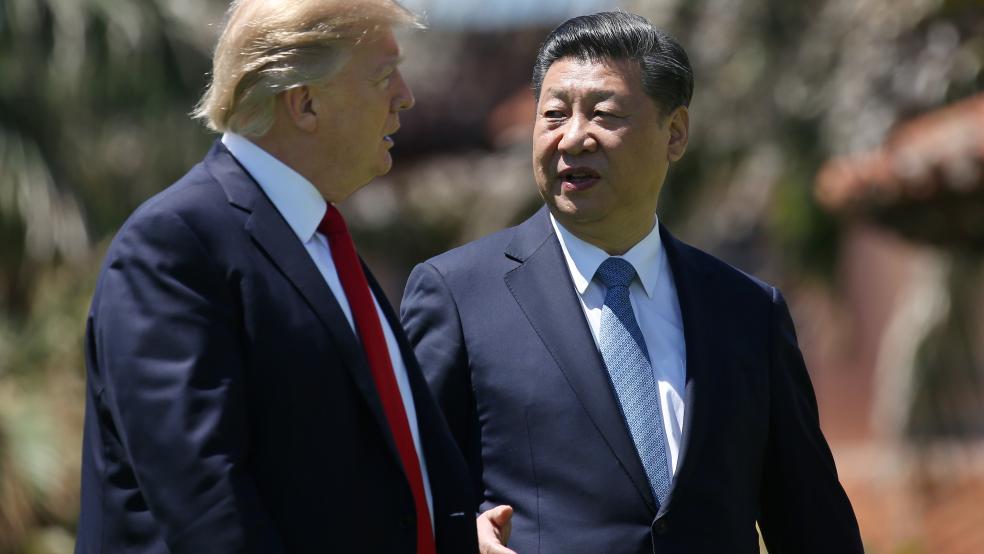President Trump has a China problem: He doesn’t know how to manage the single most important relationship the U.S. has.
While Trump still boasts of his good personal relations with Chinese President Xi Jinping, he still does not have a China policy. Despite his grand promises to remake Sino–U.S. ties when he was elected, he has exactly zero to show for them six months into his presidency.
Related: China Steps in to Fill the US Leadership Vacuum
Trump’s biggest move to date was to barter concessions on trade and currency rates in exchange for Xi’s help reining in North Korea’s nuclear program. Clearly, that didn’t work, and Trump sent out a Twitter message last week declaring his disappointment.
While I greatly appreciate the efforts of President Xi & China to help with North Korea, it has not worked out. At least I know China tried!
— Donald J. Trump (@realDonaldTrump) June 20, 2017
So far the administration is headed in the wrong direction all too swiftly. Trump needs to reverse course, and he can begin when he meets Moon Jae-in, South Korea’s just elected president, on Thursday and Friday.
There’s a lot to reverse. Secretary of State Tillerson announced Tuesday that the U.S. has once again placed China on its list of worst human traffickers. It’s now in the bin with North Korea and Syria, among others. This is a gesture with no substance, and the administration has chosen the wrong time to make it, even if it did have teeth.
The Chinese have so far objected only mildly to the State Department’s report. But that doesn’t mean Beijing hasn’t taken note. China’s record on human rights and trafficking is certainly far from spotless, but Tillerson’s report now has some lawmakers calling for sanctions against China.
Related: How China Can Fight Trump's Trade Policies
Now it’s Commerce Secretary Wilbur Ross’s turn. Administration officials said Wednesday—a day after Tillerson issued his trafficking report—that Commerce is close to protecting the U.S. steel industry on national security grounds. That would open the way to tariffs on Chinese steel imports.
Wrong move again. For one thing, Chinese steel takes a very slim slice of the U.S. market because it’s already subject to a variety of anti-dumping restrictions. For another, any steps the U.S. takes against China on the trade side should be part of a coherent strategy and emphatically should not precede negotiation. So far, there’s no sign of a strategy, and there hasn’t been any negotiation.
What about the South China Sea, where China has been developing its military presence in contested waters? Once again, Team Trump doesn’t seem to know what to do next. But the Chinese do. In April, they launched their first aircraft carrier and this week put the first of 18 new-generation destroyers in the water, each loaded with anti-missile, anti-aircraft, and anti-ship defenses.
What’s going on? Why does the new administration seem to be flailing? There are two big reasons.
First, trans–Pacific relations are easily the most complex of any Washington must manage. Trade, investment, politics, diplomacy, security: There are a lot of moving parts. They are also the most dynamic, shifting by the day because of China’s astonishingly fast emergence. Even seasoned diplomats find Asia a serious challenge.
Related: As the US Pulls Back, China Boosts Global Trade on a New Silk Road
Second, there is historically not enough coordination among those managing policy. The Pentagon has long had the biggest say in Asia, and it wants one thing. State wants another, Commerce yet another, Treasury something else, and so on. This has played out like a prime-time feature during Trump’s first six months.
Now Trump has a chance to get on a straight, unified course. It’s when he meets Moon on Thursday and Friday. Do the right thing on the Korea question, and Trump can begin to reset Washington’s deteriorating ties with China, too.
Trump, Moon, and the Chinese share a common goal—pull North Korea off its nuclear program and defuse tensions on the peninsula. But strategies differ.
Moon wants to revive Kim Dae-jung’s famous “sunshine policy,” using diplomatic contacts, aid, cross-border investment, and family-reunion programs as incentives for the North to go non-nuclear. Beijing tilts in Moon’s direction.
The Trump administration favors one or another form of coercion, primarily tighter sanctions and a stepped-up military presence. Tillerson has said several times that denuclearization must be a precondition of any negotiations between Washington and Pyongyang. Tillerson’s position is a non-starter, and Trump should drop it when he meets Moon. There’s no logic to making the goal of talks a requirement before talks begin.
Related: China's CNPC Suspends Fuel Sales to North Korea as Risks Mount
A gradual drift of opinion in Washington—away from confrontation and toward negotiation—is gaining momentum. On Wednesday, a group of heavyweights including former Secretary of State George Shultz, former Defense Secretary William Perry, and former Senator Richard Lugar sent Trump an open letter urging him to begin “informal bilateral talks—with no preconditions.”
It’s the latest of several such letters. More than 60 Democratic lawmakers sent the White House a similar message a month ago.
The Schultz–Perry letter proposed sending a “high-level presidential envoy” to Pyongyang in return for a freeze on the North’s missile and nuclear tests. Formal talks would proceed from there. “There is no guarantee diplomacy will work. But there are no good military options,” the letter said. “Time is not on our side. We urge you to put diplomacy at the top of the list of options on the table.”
It’s savvy timing, given Trump’s summit with Moon. And what Shultz and Perry urge is what China has urged for years.
The president now has three good chances to do better in Korea and restart relations with the Chinese: Give Moon a sympathetic hearing, urge Xi during their next phone call not to take the Tillerson report too seriously, and tell Wilbur Ross to hold his horses before making a move on Chinese steel.






